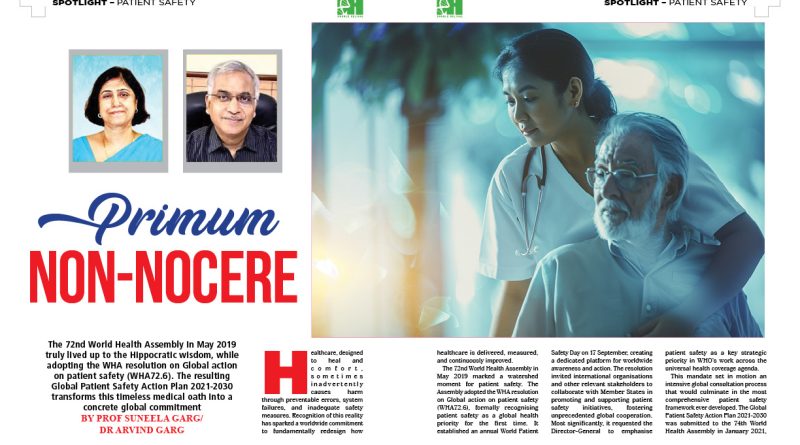Primum Non-Nocere
The 72nd World Health Assembly in May 2019 truly lived up to the Hippocratic wisdom, while adopting the WHA resolution on Global action on patient safety (WHA72.6). The resulting Global Patient Safety Action Plan 2021-2030 transforms this timeless medical oath into a concrete global commitment
By Prof Suneela Garg/ Dr Arvind Garg
Healthcare, designed to heal and comfort, sometimes inadvertently causes harm through preventable errors, system failures, and inadequate safety measures. Recognition of this reality has sparked a worldwide commitment to fundamentally redesign how healthcare is delivered, measured, and continuously improved.
The 72nd World Health Assembly in May 2019 marked a watershed moment for patient safety. The Assembly adopted the WHA resolution on Global action on patient safety (WHA72.6), formally recognising patient safety as a global health priority for the first time. It established an annual World Patient Safety Day on 17 September, creating a dedicated platform for worldwide awareness and action. The resolution invited international organisations and other relevant stakeholders to collaborate with Member States in promoting and supporting patient safety initiatives, fostering unprecedented global cooperation. Most significantly, it requested the Director-General to emphasise patient safety as a key strategic priority in WHO’s work across the universal health coverage agenda.
This mandate set in motion an intensive global consultation process that would culminate in the most comprehensive patient safety framework ever developed. The Global Patient Safety Action Plan 2021-2030 was submitted to the 74th World Health Assembly in January 2021, approved by the 74th WHA decision in May 2021, and formally launched in August 2021, marking the beginning of a new era in global healthcare safety.
A Vision of Zero Harm
The WHO Global Patient Safety Action Plan (2021-2030) embodies an ambitious yet achievable vision: “A world in which no one is harmed in healthcare, and every patient receives safe and respectful care, every time, everywhere.” This vision represents more than an aspiration—it establishes the ultimate aim to achieve zero avoidable harm in healthcare.
The plan is built on fundamental guiding principles that reshape how healthcare systems approach safety. It emphasises engaging patients and families as active partners in care, recognising that those receiving care are often best positioned to identify potential problems and contribute to solutions. The framework calls for building safety culture across all levels of health systems, transforming organisational environments from reactive problem-solving to proactive safety management.
Integration of safety into all aspects of healthcare delivery ensures that safety considerations are woven into every decision, process, and interaction rather than treated as separate add-on activities. The plan places equity, inclusiveness, and compassion as core values, recognising that safe care must be accessible to all patients regardless of their background, condition, or circumstances.
The Seven Pillars of Transformation
The Global Patient Safety Action Plan is structured around seven strategic objectives, each representing a pillar that collectively supports the transformation of healthcare systems:
1. Make Safety a National Health Priority
This foundational pillar calls for governments to integrate patient safety in policies, regulations, and legislation. It recognises that sustainable change requires political commitment and regulatory frameworks that prioritise safety at the highest levels of governance.
2. Build High-Reliability Health Systems
This objective focuses on strengthening governance, accountability, and leadership for safety. High-reliability systems are characterised by consistent performance, proactive risk management, and the ability to function safely even under challenging conditions.
3. Ensure Safe Clinical Practices
This pillar emphasises the adoption of standardised evidence-based practices across critical areas. These include medication safety protocols that prevent drug errors, surgical safety procedures that reduce operative complications, maternal and newborn safety measures that protect vulnerable populations, and infection prevention strategies that halt the spread of healthcare-associated infections.
4. Engage and Empower Patients and Families
Recognition of patients and families as partners ensures communication, transparency, and respect in all care interactions. This pillar transforms the traditional provider-patient relationship into a collaborative partnership where patients are empowered to participate actively in their safety.
5. Inspire and Strengthen Health Workforce Capacity
This objective emphasises training in safety science, teamwork, and system thinking while creating supportive and blame-free work environments. Healthcare workers must be equipped with both the knowledge and tools necessary to deliver safe care, supported by organisational cultures that encourage learning and improvement.
6. Improve Information, Measurement, and Learning
Developing indicators and metrics to track safety progress while encouraging reporting and learning from adverse events creates the foundation for evidence-based improvement. This pillar recognises that what gets measured gets managed, and systematic data collection enables targeted interventions.
7. Invest in Research, Innovation, and Technology for Safety
This pillar promotes innovations such as digital health solutions, safer technologies, and design improvements that can prevent errors and support healthcare workers in delivering safe care. Technology serves as a powerful enabler of safety when properly implemented and integrated into care processes.
Cross-Cutting Priorities for Maximum Impact
The Global Patient Safety Action Plan identifies four cross-cutting action areas that demand attention across all healthcare settings and represent the highest-impact opportunities for improvement:
Medication safety, aligned with WHO’s “Medication Without Harm” challenge, addresses one of the most common sources of preventable harm in healthcare. Medication errors can occur at multiple points in the care process, from prescribing and dispensing to administration and monitoring, making systematic approaches essential.
Infection prevention and control represents a fundamental aspect of safe care, protecting both patients and healthcare workers from preventable infections. Effective infection control requires comprehensive programs that address everything from hand hygiene and environmental cleaning to isolation procedures and antimicrobial stewardship.
Surgical safety and obstetric safety focus on high-risk, high-volume procedures where standardised protocols and safety checklists have proven highly effective. These areas offer opportunities for dramatic improvements in outcomes through relatively straightforward interventions.
Patient engagement and health literacy empowers patients to participate actively in their own safety. When patients understand their conditions, treatments, and potential risks, they become valuable partners in preventing errors and improving outcomes.
Implementation Approach: From Global Vision to Local Action
The Global Patient Safety Action Plan is designed for adoption by all Member States with national adaptation to local contexts and priorities. Implementation follows a phased approach with short-, medium-, and long-term targets extending through 2030. This timeline recognises that transforming healthcare systems requires sustained effort and allows for progressive development of capabilities and infrastructure.
The plan emphasises learning, sharing best practices, and building resilience in healthcare systems. This collaborative approach ensures that innovations and lessons learned in one setting can benefit healthcare systems worldwide, accelerating progress toward the shared vision of zero avoidable harm.
Essential Elements of Effective Patient Safety Action Plans
Successful implementation of patient safety initiatives requires comprehensive action plans that address multiple interconnected elements:
Leadership and Governance
Strong commitment from leadership to make safety a priority forms the foundation of effective patient safety programs. This includes establishing patient safety committees or governance bodies that provide oversight and direction, while defining clear accountability and responsibility at every level of the organisation.
C
ulture of Safety
Promoting a “no blame, no shame” environment for reporting errors represents perhaps the most critical cultural transformation. This approach encourages open communication between staff, patients, and families while providing regular training to build and sustain safety culture throughout the organisation.
Risk Identification and Reporting
Systematic reporting mechanisms for adverse events, near-misses, and unsafe practices enable organisations to learn from problems and prevent recurrence. These systems must include anonymous, non-punitive reporting channels that encourage staff to share safety concerns without fear of punishment. Root Cause Analysis (RCA) for critical incidents helps identify underlying system factors that contribute to errors.
Standardisation of Practices
Evidence-based clinical protocols and guidelines reduce dangerous variability in care processes. The use of checklists, such as surgical safety checklists and medication safety checklists, provides systematic approaches to complex procedures. Standard handover communication tools, such as SBAR (Situation, Background, Assessment, Recommendation), ensure critical information is effectively communicated between care providers.
Capacity Building and Training
Ongoing education of healthcare staff on safety protocols ensures that all team members understand and can implement safety measures effectively. Simulation-based training for high-risk scenarios provides opportunities to practice emergency responses and complex procedures in safe environments. Inclusion of patient safety in orientation programs ensures that new staff members understand safety as a core organisational value from their first day.
Patient and Family Engagement
Involving patients in their care planning and safety checks creates an additional layer of protection against errors. Educating patients about medications, procedures, and discharge instructions empowers them to participate actively in their care. Encouraging patients to speak up about concerns transforms them from passive recipients of care into active safety partners.
Data, Monitoring and Evaluation
Regular audits of adverse events, near-misses, and compliance with protocols provide objective measures of safety performance. Safety indicators and benchmarks enable organisations to measure progress and identify areas needing improvement. Feedback loops for continuous improvement ensure that lessons learned translate into better practices and outcomes.
Safe Use of Technology
Implementing electronic medical records (EMR) with decision-support tools can prevent medication errors and provide clinical decision support at the point of care. Barcode systems for medication safety reduce errors in drug administration. Alarm systems for critical alerts must be carefully designed and managed to provide essential warnings while avoiding alarm fatigue.
Medication and Infection Safety
Double-checks for high-risk drugs provide additional verification before administration of medications that carry significant potential for harm. Antimicrobial stewardship programs ensure appropriate use of antibiotics and reduce the development of resistant organisms. Infection prevention and control measures, including hand hygiene protocols, isolation procedures, and sterilisation practices, protect both patients and healthcare workers.
Continuous Quality Improvement
Plan-Do-Study-Act (PDSA) cycles provide systematic approaches for testing safety interventions before full implementation. Benchmarking with national and international safety goals, such as those established by WHO and accreditation organisations like the Joint Commission, helps organisations measure their performance against recognised standards. Periodic review and updating of action plans ensures that safety programs evolve based on new evidence and changing conditions.
World Patient Safety Day: A Global Platform for Change
World Patient Safety Day, observed annually on 17 September, serves as a global platform for raising awareness and mobilizing action on patient safety issues. This annual observance calls for global solidarity and concerted action by all countries and international partners to improve patient safety worldwide.
The day serves multiple critical functions in advancing the patient safety agenda. It raises global awareness about specific patient safety challenges and solutions, provides opportunities for sharing best practices and innovations across healthcare systems, mobilises political and public support for patient safety initiatives, and creates platforms for healthcare organisations to recommit to safety goals and demonstrate progress.
Each year’s observance focuses on specific aspects of patient safety, ensuring comprehensive coverage of the many factors that contribute to safe care. This focused approach enables deep exploration of particular challenges while maintaining connection to the broader patient safety agenda.
The Path Forward: Collective Commitment to Zero Harm
The vision of achieving zero avoidable harm in healthcare by 2030 represents a fundamental commitment to the principle that every patient deserves safe, respectful care. This vision is achievable through systematic implementation of evidence-based safety practices, meaningful engagement of patients and families as partners in care, and the creation of healthcare cultures that prioritise learning and continuous improvement.
The journey toward zero avoidable harm is complex and will require unprecedented coordination, but it represents one of the most important public health initiatives of our time. Every patient who enters healthcare systems deserves to receive safe, respectful care, and every healthcare worker deserves to work in an environment that supports and enables safe practice.
The framework exists, the commitment has been made, and the roadmap is clear. Success will ultimately depend on the collective dedication and sustained action of healthcare communities worldwide, working together toward the shared vision of healthcare that heals without causing harm.
(The authors are Chair, Programme Advisory Committee, National Institute of Health & Family Welfare (NIHFW); Director, Child Care Clinic, Noida; and Head, Paediatrics, Apollo Hospital, Noida.)

